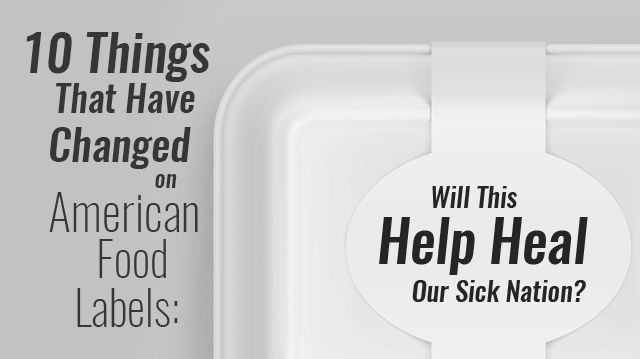
On Friday, May 20th, Michelle Obama formally announced changes to the nutritional label found on packaged foods. The label, which has not been updated in 20 years, was refreshed in order to present clearer information to consumers trying to make informed choices. Affecting over 800,000 products, the overhaul represents a milestone for the First Lady’s “Let’s Move!” campaign, which aims to help Americans live a healthier lifestyle.
Here are the most noteworthy changes:
Calorie counts are big and bold. As most Americans know, the calorie count of a packaged food product could be found toward the top of the label. Now, the word “Calories” will be more accentuated, with a larger font and bold text. The number of calories per serving will have the largest font size of the entire label, drawing the consumer’s eye to this calculation first.
There is a new line indicating added sugars. Perhaps the most controversial change, there will now be a line item below “Total Sugars,” that will read: “Includes ___g Added Sugars.” According to a recent New York Times article, “The Sugar Association said it was ‘disappointed’ by the F.D.A.’s decision to require a separate line for added sugars. It argued that the rule lacked ‘scientific justification.’” Regardless of this stance, added sugar is something that consumers want to know about.
Serving sizes will be more accurate. We’ve all been faced with the mental math problem of trying to decipher serving sizes vs. how much we actually ate. The White House press release suggests that the way that Americans consume food and drink has shifted considerably in the twenty years since the first labels were introduced. The new label is supposed to reflect modern (mostly larger) serving sizes.
Vitamins A and C are no longer required to be on the label. Toward the bottom, current labels list the daily value percentages of Vitamin A, Vitamin C, Iron, and Calcium. Moving forward, Vitamin A and C will become optional for manufacturers to include.
Instead, Vitamin D and Potassium will take their place. Cited as two nutrients that Americans notoriously don’t consume enough of, Vitamin D and Potassium will now be required for the new label.
Vitamins and minerals will have a numerical measurement. Right now, the line items containing vitamin and mineral information are listed only with percentages based on a 2,000-calorie diet. With the new label, the four key vitamins and minerals will be listed with a percentage as well as a measurement in grams or micrograms, so consumers can better contextualize the contents.
The daily values will be tweaked. According to the FDA, “Daily values for nutrients like sodium, dietary fiber and vitamin D are being updated based on newer scientific evidence from the Institute of Medicine and other reports such as the 2015 Dietary Guidelines Advisory Committee Report, which was used in developing the 2015-2020 Dietary Guidelines for Americans.” For instance, the daily recommended threshold for grams of fiber will be increased. While this particular change might not be as apparent to consumers, the daily value percentage will be modified to demonstrate more current nutritional recommendations.
The explanation of “% daily value” will be more concise. The labels we are used to contain some fine print at the bottom, detailing that the percentages on the label are based on a 2,000 calorie diet. Below that, there is a chart with fat, saturated fat, cholesterol, sodium, carbohydrate, and fiber guidelines for those on a 2,000 or 2,500 calorie diet. The chart, in small font, requires a few moments of studying to figure out what it is indicating. Additionally, the 2,000 and 2,500 measurements seem rather arbitrary. The new label will nix the chart altogether and merely state: “ The % Daily Value (DV) tells you how much a nutrient in a serving of food contributes to a daily diet. 2,000 calories a day is used for general nutrition advice.”
The order of the line items will change somewhat. The “servings per container” line will come first, and swap with the “serving size” line, which will come second.
There will be no listing of “Calories from fat.” The category, which we are used to seeing to the right of the calorie count, has been eliminated altogether. In its press release, The White House mentions that part of the reason for the new label is significant scientific developments between 1993 and today. As we now know that some fat is “good fat,” the “calories from fat” the argument is that this measurement isn’t particularly meaningful.
The changes, which must be implemented by manufacturers in the next 2-3 years, seem to be well-intentioned. We are a nation plagued with diabetes, obesity, and heart disease, so anything that helps consumers better understand the food they are eating is a positive. With the citation that approximately 77% of Americans do read these labels, hopefully this is a significant step toward helping Americans change their diet for the better.
—Brett Murphy Hunt
Sources:
https://www.whitehouse.gov/the-press-office/2016/05/20/white-house-and-fda-announce-modernized-nutrition-facts-label
http://www.nytimes.com/2016/05/21/health/fda-nutrition-labels.html?_r=0
http://vitals.lifehacker.com/added-sugars-will-now-be-on-nutrition-labels-no-more-1777822072
http://www.fda.gov/downloads/Food/GuidanceRegulation/GuidanceDocumentsRegulatoryInformation/LabelingNutrition/UCM501646.pdf
http://www.fda.gov/Food/GuidanceRegulation/GuidanceDocumentsRegulatoryInformation/LabelingNutrition/ucm385663.htm#images
https://www.consumeraffairs.com/news/new-nutrition-labels-aim-to-help-reduce-obesity-diabetes-heart-disease-052016.html

